 |
 |
 |
| |
Antiretroviral CNS Penetration-Effectiveness (CPE) 2010 ranking predicts CSF viral suppression only in patients with undetectable HIV-1 RNA in plasma
|
| |
| |
Reported by Jules Levin
CROI 2011 Boston
Andrea Antinori1, Patrizia Lorenzini1, Maria Letizia Giancola1, Giovanna Picchi1, Francesco Baldini1, Laura Monno2, Adriana Ammassari1, Antonella d'Arminio Monforte3, Paola Cinque4, Valerio Tozzi1
1National Institute for Infectious Diseases "Lazzaro Spallanzani", IRCCS, Rome, Italy; 2University of Bari, Italy; 3San Paolo Hospital, University of Milan, Italy; 4HSR San Raffaele Scientific Institute, Milan, Italy
AUTHOR CONCLUSIONS
· CPE 2010 ranking strongly predicts HIV-1 replication in CSF
during plasma viral suppression, but does not have the same
predictive value in individuals with plasma active replicating
virus.
· This could be explained by some factors, such as HIV drug
resistance, poor adherence or intrathecal immune activation that
may offset CPE in the context of virological failure and could lead
to a compartmentalization between plasma and CNS.
· These results may have relevant implications for clinical
strategy in order to define patients at higher risk of CSF/plasma
discordant HIV-1 suppression and could be useful for the
clinicians to choose the more effective antiretroviral therapy for
subsets of patients
· Including neuroactive drugs in the cART regimen could be
considered in the group of patients with complete virological
suppression in plasma in order to better control the HIV
replication in CSF and preserve CNS from neurocognitive and
neurological disorders.
ABSTRACT
Background. HIV-1 replication in CSF despite viral suppression in plasma has been suggested as associated with neurocognitive impairment and neurological disease. Higher CPE ranking (2010 version) was related to lower proportion of detectable CSF viral load in a retrospective cross-sectional analysis, and lower ranking correlated to time-to-loss-of-viral response in CSF longitudinally. Information on predictive value of CPE ranking according to level of HIV-1 suppression in plasma are still unclear.
Methods.Retrospective analysis of consecutive paired CSF/plasma samples from HIV infected patients followed at four clinical centers in Italy. Plasma and CSF lower limits of quantification were defined by standard methods at the time of collection (range 50-200 cp/mL). Independent predictors of CSF undetectable viral load were assessed by multivariate linear regression method.
Results. A total of 301 paired CSF/plasma samples obtained from 219 HIV-infected patients treated by cART (years 1999-2009) were included in the analysis (male 81%; median age 42; heterosexual 37%, MSM 15%, IVDU 38%; previous AIDS-defining event 65%).
Median CD4 count was 129 cells/ml and HIV-1 RNA values in CSF and plasma were 2.39 log10/mL and 2.06 log10/mL, respectively.
A neurologic disorder was diagnosed in 56% of patients. Of the 301 paired samples, 107 (35%) had undetectable HIV-1 RNA in plasma, and 155 (51%) undetectable values in CSF.
Overall median value of antiretroviral CPE 2010 ranking was 7 (IQR 6-8). Results of multivariate analysis are reported in Table 1. Sensitivity analysis indicated CPE ranking cutoff of 6 as highly predictive. Age, gender, HIV transmission route, number of ARV drugs, ARV drug class (PI/r, PI, or NNRTI) did not correlate in univariate analysis and were not included in the final model.
Table 1. Factors predictive of undetectable HIV-1 RNA in CSF by multivariable linear regression according to plasma HIV-1 RNA at the time of CSF collection.
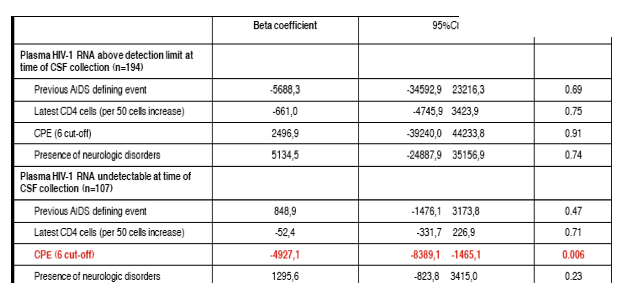
Conclusions
CPE 2010 ranking strongly predicts HIV-1 replication in CSF during plasma viral suppression, but does not have the same predictive value in individuals with plasma active replicating virus. This could be explained by other factors, such as HIV drug resistance, poor adherence or immune activation that may offset CPE in the context of virological failure. These results may have relevant implications for clinical strategy in order to define patients at higher risk of CSF/plasma discordant HIV-1 suppression.
Introduction
Combined Antiretroviral Therapy (cART) is been demonstrated to be effective in reducing HIV viral load in plasma as well as in CSF.
· However, cARTcould be not sufficient to control HIV replication in CNS for a lot of reasons, such as the variable concentrations that antiretroviral drugs reach into the anatomical reservoirs. A compartmentalization between plasma and CNS has been demonstrated.
· In fact some evidences show that in some patients HIV replication in CSF continues in spite of a long and complete viral suppression in their plasma and neurological and neurocognitive disorders could be recognized.
· In the most recent years some efforts to identify antiretroviral drugs or regimens that could be more effective than others in controlling HIV replication in CSF have been done.
· Antiretroviral CSF Penetration-Effectiveness (CPE) score has been proposed by CHARTER Group in order to evaluate the relationship between CSF HIV-RNA, antiretroviral penetration in CSF, and neurocognitive impairment.
· Higher CPE ranking (2010 version) has been related to lower proportion of detectable CSF viral load in a retrospective cross-sectional analysis, and lower ranking correlated to time-to-loss-of viral response in CSF longitudinally.
· Information on predictive value of CPE ranking according to level of HIV-1 suppression in plasma are still unclear.
Objective
· To analyze the effect of cART on CSF HIV–RNA replication in a large group of HIV-infected patients.
· To identify predictive factors associated to CSF HIV-RNA load in the study group.
· To explore the predictive value of CPE ranking according to level of HIV-1 suppression in plasma.
Methods
· A retrospective analysis on consecutive paired CSF/plasma samples from HIV infected patients attending four clinical centers in Italy was conducted
· Plasma and CSF lower limits of quantification were defined by standard methods at the time of collection (range 50-200 cp/mL).
· Independent predictors of CSF viral load were assessed by multivariate linear regression method.
· CPE score considers pharmacokinetics characteristics of antiretrovirals and classifies the drugs into 4 classes; the rank varies from 1 to 4 (table 1). A 6 cut-off was choosen according to a sensitivity analysis.
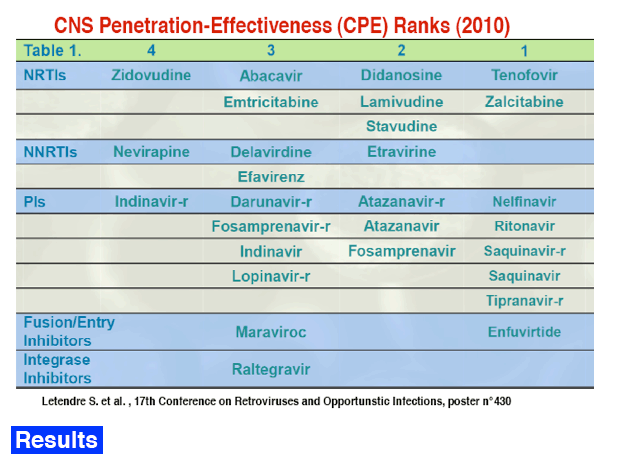
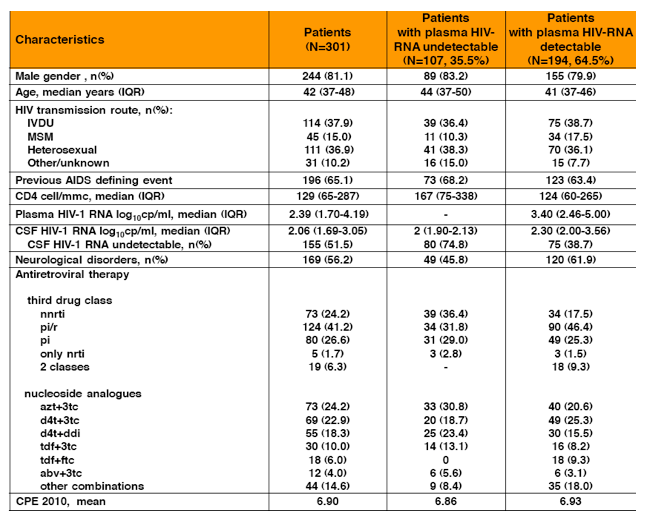
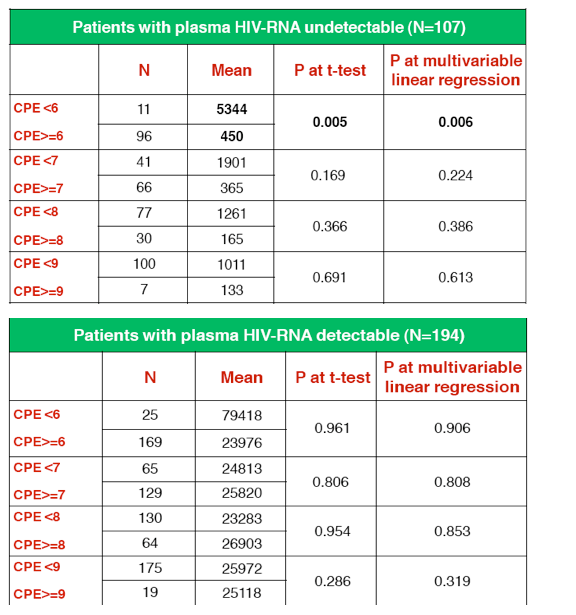
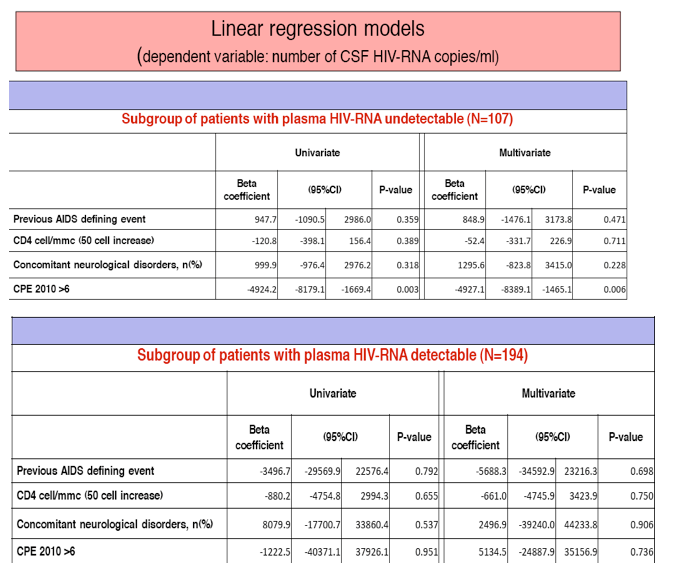
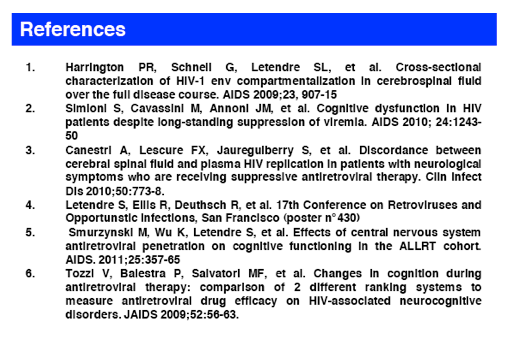
|
| |
|
 |
 |
|
|